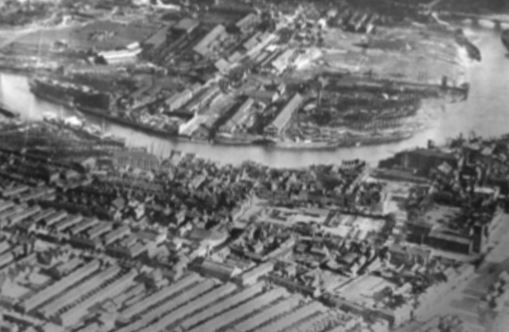War, empire and industry are intricately linked in the history of North East shipbuilding. As an island nation, Britain relied on ships for war, trade and colonial expansion. The wooden 'tall ships' may seem romantic to us today, but they were important tools of the powerful British Empire, used for sea battles and to transport sodliers and colonisers overseas, as well as to carry goods.
.png) Most of the ships built during the 19th century were sailing ships, although from the 1880s, iron was increasingly used in response to demand for coal to power the industrial revolution.
Most of the ships built during the 19th century were sailing ships, although from the 1880s, iron was increasingly used in response to demand for coal to power the industrial revolution.
The coal that powered the industrial revolution was abundant in the North East, and the need to transport it quickly and cheaply to other parts of the world (but in particular London) drove innovation. In response to the steam train engine, invented by Newcastle engineer George Stephenson, marine engineers developed steam-driven colliers (ships to transport coal). During the industrial revolution and up until the early 20th century, Britain was the world leader in shipbuilding, and the North East was the main producer of ships.
During this period, the North East has been described as a 'frontier' region. Demand for workers in the mines, shipyards and other heavy engineering saw a huge increase in the population from, with many migrants coming from Ireland and Scotland, as well as Scandanavian countries and British colonies. For example, South Shields was home to the UK's first Muslim community, Yemenis who came as merchant seamen and married into the local population.
At the end of the 19th century, war once again drove shipbuilding innovation in the region. In the aftermath of the Crimean War, local entrepreneur William Armstrong revolutionised modern armaments. The Swing Bridge on the Tyne was built in 1876 to allow the gunships built at his famous Elwick Yard in the West End of Newcastle to travel down the river. Armstrong saw himself as an engineer first -- he sold his warships to other countries, not just England, and did not consider himself responsible for the uses his inventions were put to.
Shipbuilding was never a stable industry, and many yards came and went throughout the industrial era. Changes in technology meant shipbuilding needed to constantly evolve, changing from sail to steam to electric turbines, and from wood to iron to steel. Many marine engineering firms developed to service the shipbuilders, along with other industries such as roperies. Ship repair was also important to keep the ships running once they were launched, and ship breakers demolished the ships that were no longer seaworthy.
(Image courtesy of Stockton Reference Library)
By the first decade of the 20th century, the North East produced a quarter of the world’s ships in terms of ‘tonnage’ – the volume (in tons) that a ship can carry. However, as the British Empire began to decline in strength, so too did its share of the shipbuilding trade.
